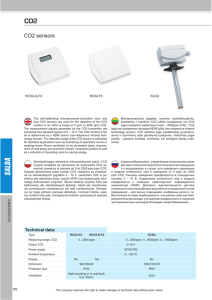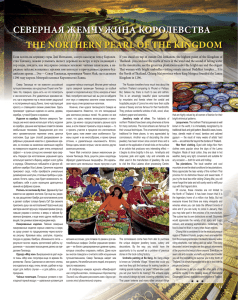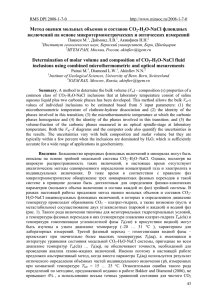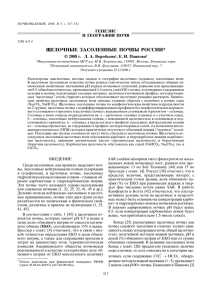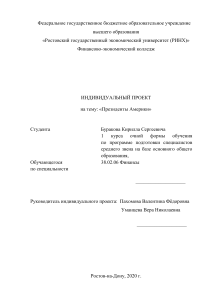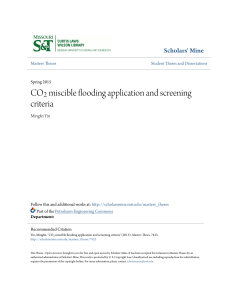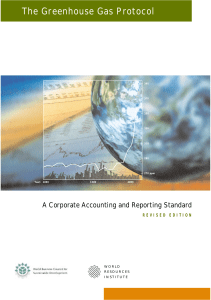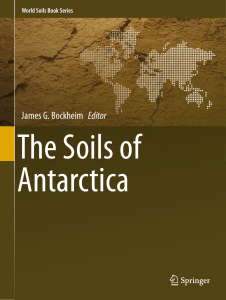Р К И
advertisement
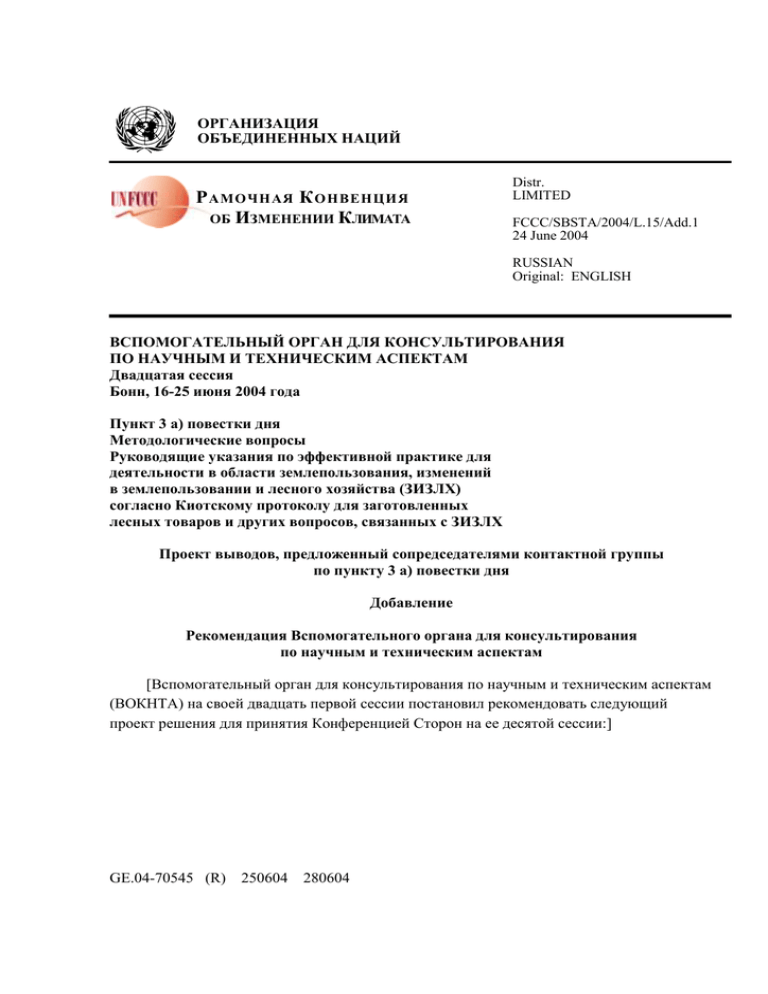
ОРГАНИЗАЦИЯ ОБЪЕДИНЕННЫХ НАЦИЙ Р АМОЧНАЯ К ОНВЕНЦИЯ ОБ ИЗМЕНЕНИИ КЛИМАТА Distr. LIMITED FCCC/SBSTA/2004/L.15/Add.1 24 June 2004 RUSSIAN Original: ENGLISH ВСПОМОГАТЕЛЬНЫЙ ОРГАН ДЛЯ КОНСУЛЬТИРОВАНИЯ ПО НАУЧНЫМ И ТЕХНИЧЕСКИМ АСПЕКТАМ Двадцатая сессия Бонн, 16-25 июня 2004 года Пункт 3 а) повестки дня Методологические вопросы Руководящие указания по эффективной практике для деятельности в области землепользования, изменений в землепользовании и лесного хозяйства (ЗИЗЛХ) согласно Киотскому протоколу для заготовленных лесных товаров и других вопросов, связанных с ЗИЗЛХ Проект выводов, предложенный сопредседателями контактной группы по пункту 3 а) повестки дня Добавление Рекомендация Вспомогательного органа для консультирования по научным и техническим аспектам [Вспомогательный орган для консультирования по научным и техническим аспектам (ВОКНТА) на своей двадцать первой сессии постановил рекомендовать следующий проект решения для принятия Конференцией Сторон на ее десятой сессии:] GE.04-70545 (R) 250604 280604 FCCC/SBSTA/2004/L.15/Add.1 page 2 Проект решения -/СР.10 [Руководящие указания по эффективной практике для деятельности в области землепользования, изменений в землепользовании и лесного хозяйства согласно пунктам 3 и 4 статьи 3 Киотского протокола] Конференция Сторон, ссылаясь на решения 11/СР.7, 19/СР.7, 21/СР.7, 22/СР.7, и 13/СР.9, [1. рекомендует Конференции Сторон, выступающей в качестве совещания Сторон Киотского протокола, принять приводимый ниже проект решения -/СМР.1 (Руководящие указания по эффективной практике для землепользования, изменений в землепользовании и лесного хозяйства согласно пунктам 3 и 4 статьи 3 Киотского протокола),]; 2. призывает Стороны, включенные в приложение I к Конвенции, ратифицировавшие Киотский протокол, представлять на добровольной основе прогнозы выбросов парниковых газов в разбивке по источникам и абсорбции поглотителями в результате деятельности согласно пунктам 3 и 4 статьи 3 Киотского протокола в своих материалах, подлежащих представлению 15 апреля 2007 года, используя таблицы общей формы докладов1 для деятельности согласно пунктам 3 и 4 статьи 3 Киотского протокола, содержащиеся в приложении II к настоящему решению, и дополнительную информацию, подлежащую включению в приложение к национальному докладу о кадастре, указанную в приложении I к настоящему решению; 3. призывает Стороны сообщить в секретариат до 30 июня 2007 года свои мнения относительно таблиц, упомянутых в пункте 2 выше, и об опыте их использования; 4. просит секретариат синтезировать точки зрения Сторон для рассмотрения Вспомогательным органом для консультирования по научным и техническим аспектам на его двадцать седьмой сессии; 1 Общая форма докладов представляет собой стандартизованную форму для использования Сторонами с целью представления в электронной форме прогнозов выбросов и абсорбции парниковых газов и любой другой соответствующей информации. По техническим причинам (например, размер таблиц и шрифтов) формат печатного варианта таблиц общей формы докладов для землепользования и изменений в землепользовании и лесного хозяйства в этом документе не может быть стандартизован. FCCC/SBSTA/2004/L.15/Add.1 page 3 5. просит Вспомогательный орган для консультирования по научным и техническим аспектам после рассмотрения опыта, приобретенного при использовании таблиц, упомянутых в пункте 2 выше, обновить эти таблицы и включить их в приложение к решению, упомянутому в пункте 1 выше; 6. просит секретариат разработать, при условии наличия дополнительного финансирования, предварительный модуль для таблиц, упомянутых в пункте 2 выше, в целях содействия подготовке материалов, подлежащих представлению 15 апреля 2007 года. FCCC/SBSTA/2004/L.15/Add.1 page 4 ПРИЛОЖЕНИЕ I Руководящие указания по представлению дополнительной информации о деятельности в области землепользования, изменений в землепользовании и лесного хозяйства (ЗИЗЛХ) согласно статье 3.3 и 3.4, подлежащей включению в приложение к национальному докладу о кадастре 1. В настоящем приложении содержатся руководящие указания по представлению дополнительной информации о деятельности в области землепользования, изменений в землепользовании и лесного хозяйства (ЗИЗЛХ) согласно статье 3.3. и 3.4, подлежащей включению в национальный доклад о кадастре2 (НДК). Эти руководящие указания предоставляются для оказания помощи Сторонам в выполнении ими требований решения 22/СР.7 и основаны, в необходимых случаях, на Руководящих указаниях МГЭИК по эффективной практике для землепользования, изменений в землепользовании и лесного хозяйства (Руководящие указания МГЭИК для ЗИЗЛХ). Дополнительная информация может быть включена в НДК в зависимости от национального подхода Стороны к прогнозированию выбросов и абсорбции парниковых газов (ПГ) в области ЗИЗЛХ согласно Киотскому протоколу. 2. В соответствии с приводимыми ниже руководящими указаниями Сторонам следует сообщать: а) общую информацию b) информацию, относящуюся к землям с) информацию по конкретным видам деятельности d) прочую информацию е) информацию, относящуюся к статье 6. 3. Информацию о конкретных видах деятельности следует сообщать по каждому виду деятельности согласно статье 3.3 и по каждому избранному виду деятельности в соответствии со статьей 3.4. Поскольку и облесение и лесовозобновление являются 2 Национальный доклад о кадастре представляется в соответствии с решением 18/СР.8 с поправками, внесенными решением 13/СР.9. FCCC/SBSTA/2004/L.15/Add.1 page 5 объектом одних и тех же положений, указанных в приложении к проекту решения -/СМР.1 (Землепользование, изменения в землепользовании и лесное хозяйство), прилагаемому к решению 11/СР.7, они могут сообщаться совместно. 1. 2. 3. Общая информация 1.1 Определение леса (как в таблице НДК 1.1) и любые другие критерии (например, минимальная ширина) 1.2 Избранные виды деятельности согласно статье 3.4 (как в таблице НДК 1) 1.3 Описание того, как применялись определения каждого вида деятельности согласно статье 3.3 и каждого избранного вида деятельности согласно статье 3.4 1.4 Описание существовавших условий и/или иерархии между видами деятельности согласно статье 3.4 и того, как они последовательно применялись при осуществлении классификации земли. Информация, относящаяся к землям 2.1 Единица пространственной оценки, использовавшаяся для определения площади земельных единиц согласно статье 3.3 (в соответствии с пунктом 3 приложения к проекту решения -СМР.1 (Землепользование, изменения в землепользовании и лесное хозяйство), прилагаемого к решению 11/СР.7 2.2 Методология, использовавшаяся для разработки матрицы преобразования для земель в таблице НДК 2 2.3 Карты и/или база данных для определения географического местоположения и система определения кодов для географического местоположения, все из которых могут представляться в электронной форме. Информация по конкретным видам деятельности 3.1 Методы прогнозирования изменений в накоплении углерода и выбросов и абсорбции ПГ 3.1.1 Описание использованных методологий и лежащих в их основе посылок FCCC/SBSTA/2004/L.15/Add.1 page 6 3.1.2 Основание для исключения какого-либо углеродного пула или выбросов/абсорбции ПГ в результате деятельности согласно статье 3.3 и избранных видов деятельности согласно статье 3.4 (таблица НДК 1 должна сопровождаться такой информацией во всех случаях, когда представляется НД) 3.1.3 Информация о том, исключались ли косвенные или природные выбросы и абсорбция ПГ 3.1.4 Изменения в данных и методах со времени представления предыдущего доклада (пересчеты) (см. в том числе раздел 4.2.4.1 руководящих указаний по эффективной практике МГЭИК для ЗИЗЛХ) 3.1.5 Оценки неопределенности (см., в том числе, раздел 5.2 руководящих указаний МГЭИК для ЗИЗЛХ) 3.1.6 Информация о других методологических вопросах (например, интервалы измерений, межгодичная переменность) (см., в том числе, раздел 4.2.3 руководящих указаний по эффективной практике МГЭИК для ЗИЗЛХ) 3.1.7 Для целей учета, требующегося в пункте 18 приложения к проекту решения -/СМР.1 (Землепользование, изменения в землепользовании и лесное хозяйство), прилагаемого к решению 11/СР.7, указание года начала деятельности, в случае если это происходит после 2008 года. 3.2 Статья 3.3 3.2.1 Информация, демонстрирующая, что деятельность согласно статье 3.3 началась 1 января 1990 года или позднее и до 31 декабря 2012 года и непосредственно вызвана деятельностью человека 3.2.2 Информация о том, каким образом нарушения сельскохозяйственной деятельности или ущерб лесам, за которым следует лесовозобновление, отличаются от обезлесения 3.2.3 Информация о размерах и географическом местоположении лесных районов, утративших лесной покров, но которые пока еще не классифицируются как обезлесенные. FCCC/SBSTA/2004/L.15/Add.1 page 7 3.3 Статья 3.4 3.3.1 Информация, демонстрирующая, что деятельность согласно статье 3.4 произошла после 1 января 1990 года и вызвана деятельностью человека 3.3.2 Информация, относящаяся к управлению пахотными землями, управлению пастбищными угодьями и восстановлению растительного покрова, в случае произведения выбора, за базовый год 3.3.3 [Информация, относящаяся к управлению лесным хозяйством: а) о том, что определение леса для этой категории соответствует определению в пункте 1.1 выше b) о том, что управление лесным хозяйством представляет собой систему практики для сохранения и использования лесных земель, направленную на выполнение соответствующих экологических (включая биологическое разнообразие), экономических и социальных функций леса на устойчивой основе (пункт 1 f) приложения к проекту решения -/СМР.1 (Землепользование, изменения в землепользовании и лесное хозяйство), прилагаемых к решению 11/СР.7).] 4. Прочая информация 4.1 5. Анализ ключевой категории для деятельности согласно статье 3.3 и любые избранные виды деятельности согласно статье 3.4 (как, в том числе, в таблице НДК 3 раздела 5.4 руководящих указаний по эффективной практике МГЭИК для ЗИЗЛХ). Информация, относящаяся к статье 6 Вариант 1: [Идентификационный код в таблицах 5(КР-I)А.1.1, 5(КР-I)А.1.2, 5(КР-I)В.1, 5(КР-I)В.3 и 5(КР-I)В.4 должен содержать конкретное указание на то, подлежит ли соответствующая земля охвату проектом в соответствии согласно статье 6 Киотского протокола.] Вариант 2: [Идентификационный код должен включать конкретное указание на то, охватывает ли граница географического района землю, подлежащую охвату проектом согласно статье 6 Киотского протокола.] Change in carbon pool reported(1) Activity Aboveground biomass Belowground biomass Litter Dead wood Greenhouse gas sources reported(2) Soil Fertilization(3) N2O Disturbance Drainage of associated soils under with landforest use management conversion to croplands N2O N2O Biomass burning(4) Liming CO2 CO2 CH4 N2O Afforestation and Article 3.3 Reforestation activities Deforestation Forest Management Cropland Article 3.4 Management activities Grazing Land Management Revegetation (1) Indicate R (reported), NR (not reported), IE (included elsewhere) or NO (not occuring), for each relevant activity under Article 3.3 or elected activity under Article 3.4. If changes in a carbon pool are not reported, it must be demonstrated in the NIR that this pool is not a net source of greenhouse gases. Indicate NA (not applicable) for each activity that is not elected under Article 3.4. Explanation about the use of notation keys should be provided in the text. (2) Indicate R (reported), NE (not estimated), IE (included elsewhere) or NO (not occuring) for greenhouse gas sources reported, for each relevant activity under Article 3.3 or elected activity under Article 3.4. Indicate NA (not applicable) for each activity that is not elected under Article 3.4. Explanation about the use of notation keys should be provided in the text. (3) N2O emissions from fertilization for Cropland Management, Grazing Land Management and Revegetation should be reported in the Agriculture sector. If a Party is not able to separate fertilizer applied to Forest Land from Agriculture, it may report all N2O emissions from fertilization in the Agriculture sector. (4) If CO2 emissions from biomass burning are not already included under changes in carbon stocks, they should be reported under biomass burning; this also includes the carbon component of CH4. Parties that include CO2 emissions from biomass burning in their carbon stock change estimates should report IE (included elsewhere). Table NIR 1.1 Additional information Selection of parameters for defining "Forest"under the Kyoto Protocol Parameter Minimum land area Minimum crown cover Minimum height Range 0.05 - 1 ha 10 - 30 % 2-5m FCCC/SBSTA/2004/L.15/Add.1 page 8 TABLE NIR 1. SUMMARY TABLE Activity coverage and other information relating to activities under Article 3.3 and elected activities under Article 3.4 Table NIR 2. LAND TRANSITION MATRIX Area change between the previous and the current inventory year (1), (2), (3) TO FROM Article 3.3 activities Article 3.4 activities Afforestation Deforestation Forest Cropland Grazing Land Revegetation and Management Management Management (if elected) reforestation (if elected) (if elected) (if elected) Other Total (kha) Afforestation and Article 3.3 Reforestation activities Deforestation Forest Management (if elected) Cropland Management(4) (if elected) Article 3.4 Grazing Land activities Management(4) (if elected) Revegetation(4) (if elected) Total area (1) This table should be used to report land area and changes in land area subject to the various activities in the inventory year. For each activity it should be used to report area change between the previous year and the current inventory year. For example, the total area of land subject to Forest Management in the year preceeding the inventory year, and which was deforested in the inventory year, should be reported in the cell in column B and in the row of Forest Management. (2) Some of the transitions in the matrix are not possible and the cells concerned have been shaded. (3) In accordance with section 4.2.3.2 of the IPCC good practice guidance for LULUCF, the value of the reported area subject to the various activities under Article 3.3 and 3.4 for the inventory year should be that on 31 December of that year. (4) Lands subject to Cropland Management, Grazing Land Management or Revegetation which, after 2008, are subject to activities other than those under Article 3.3 and 3.4, should still be tracked and reported under Cropland Management, Grazing Land Management or Revegetation, respectively. FCCC/SBSTA/2004/L.15/Add.1 page 9 Other KEY CATEGORIES OF EMISSIONS AND REMOVALS GAS COMMENTS (3) CRITERIA USED FOR KEY CATEGORY IDENTIFICATION Associated category in UNFCCC Category contribution is inventory(1) is key (indicate which greater than the smallest category) category considered key in the UNFCCC inventory (1) (including LULUCF) Country Year Submission Other (2) Specify key categories according to the national level of disaggregation used(1) For example: Cropland Management CO2 X (Cropland remaining Cropland) (1) (2) (3) See section 5.4 of the IPCC good practice guidance for LULUCF. This should include qualitative consideration as per section 5.4.3 of the IPCC good practice guidance for LULUCF or any other criteria. Describe the criteria identifying the category as key. Documentation box: Parties should provide in the NIR the full information on methodologies used for identifying key categories (according to section 5.4 of the IPCC good practice guidance for LULUCF). FCCC/SBSTA/2004/L.15/Add.1 page 10 TABLE NIR 3. SUMMARY OVERVIEW FOR KEY CATEGORIES FOR LULUCF ACTIVITIES UNDER THE KYOTO PROTOCOL TABLE 5(KP) REPORT OF SUPPLEMENTARY INFORMATION FOR LAND USE, LAND-USE CHANGE AND FORESTRY ACTIVITIES UNDER THE KYOTO PROTOCOL (1), (2) GREENHOUSE GAS SOURCE AND SINK ACTIVITIES Net CO2 emissions/ removals(3), (4) (Gg) A CH4 (5) B Country Year Submission N2O (6) C A. Article 3.3 activities A.1. Afforestation and Reforestation (7) A.1.1. Units of land not harvested since the beginning of the commitment period A.1.2. Units of land harvested since the beginning of the commitment period A.2. Deforestation B. Article 3.4 activities B.1. Forest Management (if elected) B.2. Cropland Management (if elected) B.3. Grazing Land Management (if elected) B.4. Revegetation (if elected) Documentation box Parties should provide detailed explanation on the land use, land-use change and forestry sector in the relevant annex of the NIR: Supplementary information on LULUCF activities under the Kyoto Protocol. Use this documentation box to provide references to relevant sections of the NIR if any additional details are needed to understand the content of this table. (1) All estimates in this table include emissions and removals from projects under Article 6 hosted by the reporting Party. If Cropland Management, Grazing Land Management and/or Revegetation are elected, this table and all relevant tables should also be reported for the base year for these activities. (3) According to the Revised 1996 IPCC Guidelines, for the purposes of reporting, the signs for removals are always negative (-) and for emissions positive (+). Net changes in carbon stocks are converted to CO2 by multiplying C by 44/12 and by changing the sign for net CO2 removals to be negative (-) and net CO2 emissions to be positive (+). (4) CO2 emissions from liming, biomass burning and drained organic soils, where applicable, are included in this column. (5) CH4 emissions reported here for Cropland Management, Grazing Land Management and Revegetation, if elected, include only emissions from biomass burning (with the exception of savannah burning and agricultural residue burning which are reported in the Agriculture sector). Any other CH4 emissions from Agriculture should be reported in the Agriculture sector. (6) N2O emissions reported here for Cropland Management, if elected, include only emissions from biomass burning (with the exception of savannah burning and agricultural residue burning which are reported in the Agriculture sector) and N2O from conversion to Cropland of lands other than Forest Land (Table 5(KP-II)3). Any other N2O emissions from Agriculture should be reported in the Agriculture sector. (7) As both Afforestation and Reforestation under Article 3.3 are subject to the same provisions specified in the annex to draft decision -/CMP.1 (Land use, land-use change and forestry), attached to decision 11/CP.7, they can be reported together. * On all CRF tables, please use, as applicable, the notation keys as specified in the annex to decision 18/CP.8. (2) FCCC/SBSTA/2004/L.15/Add.1 page 11 GEOGRAPHICAL LOCATION (3) ACTIVITY DATA IMPLIED CARBON STOCK CHANGE FACTORS (7) Carbon stock change in above-ground biomass per area(5), (6) Identification code Subdivision(4) Carbon stock change in below-ground biomass per area(5), (6) Net Net carbon carbon Area stock stock subject change change to the in dead Net Net in litter wood activity Gains Losses Gains Losses per change change per area(5) area(5) (kha) (Mg C/ha) Country Year Submission CHANGE IN CARBON STOCK (7) Net carbon stock change in soils per area(5) Implied emission/ removal factor per area (8) (Mg CO2/ha) Carbon stock change in above-ground biomass(5), (6) Carbon stock change in below-ground biomass(5), (6) Net CO2 Net Net Net carbon carbon carbon emissions/ removals stock stock stock (8) change change change Net Net in litter in dead in soils Gains Losses Gains Losses (5) (5) change change wood(5) (Gg C) (Gg CO2) Total for activity A.1.1 [specify identification code] [specify subdivision] [specify subdivision] [specify identification code] … [specify subdivision] … Documentation box Parties should provide detailed explanation on the land use, land-use change and forestry sector in the relevant annex of the NIR: Supplementary information on LULUCF activities under the Kyoto Protocol. Use this documentation box to provide references to relevant sections of the NIR if any additional details are needed to understand the content of this table. (1) Report here information on anthropogenic change in carbon stock for the inventory year for all geographical locations that encompass units of land subject to Afforestation and Reforestation under Article 3.3 not harvested since the beginning of the commitment period. (2) As both Afforestation and Reforestation under Article 3.3 are subject to the same provisions specified in the annex to draft decision -/CMP.1 (Land use, land-use change and forestry), attached to decision 11/CP.7, they can be reported together. (3) Geographical location refers to the boundaries of the areas that encompass units of land subject to Afforestation and Reforestation. (4) Activity data may be further subdivided according to climate zone, management system, soil type, vegetation type, tree species, ecological zone, national land classification or other criteria. Complete one row for each subdivision. (5) The signs for estimates of gains in carbon stocks are positive (+) and of losses in carbon stocks are negative (-). (6) In all cases where the good practice guidance methods used give separate estimates of gains and losses, these estimates should be reported. (7) Note that net change corresponds to increase/decrease of carbon stock (see table 4.2.6a of the IPCC good practice guidance for LULUCF). (8) According to the Revised 1996 IPCC Guidelines, for the purposes of reporting, the signs for removals are always negative (-) and for emissions positive (+). Net changes in carbon stocks are converted to CO2 by multiplying C by 44/12 and changing the sign for net CO2 removals to be negative (-) and for net CO2 emissions to be positive (+). FCCC/SBSTA/2004/L.15/Add.1 page 12 TABLE 5(KP-I)A.1.1. SUPPLEMENTARY BACKGROUND DATA ON CARBON STOCK CHANGES AND NET CO2 EMISSIONS AND REMOVALS FOR LAND USE, LANDUSE CHANGE AND FORESTRY ACTIVITIES UNDER THE KYOTO PROTOCOL Article 3.3 activities: Afforestation and Reforestation (1), (2) Units of land not harvested since the beginning of the commitment period Country TABLE 5(KP-I)A.1.2. SUPPLEMENTARY BACKGROUND DATA ON CARBON STOCK CHANGES AND NET CO2 EMISSIONS AND REMOVALS FOR LAND USE, LANDUSE CHANGE AND FORESTRY ACTIVITIES UNDER THE KYOTO PROTOCOL Article 3.3 activities: Afforestation and Reforestation (1), (2) Units of land harvested since the beginning of the commitment period GEOGRAPHICAL LOCATION (3) Identification code ACTIVITY DATA Subdivision(4) IMPLIED CARBON STOCK CHANGE FACTORS(7) Carbon stock change Carbon stock change Net in above-ground in below-ground carbon Area biomass per area(5), (6) biomass per area (5), (6) stock subject change to the in litter activity Gains Losses Net Gains Losses Net change change per(5) area (kha) (Mg C/ha) Net carbon stock change in dead wood per area(5) Year Submission CHANGE IN CARBON STOCK(7) Net carbon stock change in soils per area(5) Implied emission/ removal factor per area (8) (Mg CO2/ha) Carbon stock change in above-ground biomass(5), (6) Carbon stock change in Net below-ground biomass(5), (6) carbon stock change Net Net in litter Gains Losses Increase Decrease (5) change change Net carbon stock change in dead wood(5) (Gg C) Net CO2 Net carbon emissions/ stock removals (8) change in soils (5) (Gg CO2) Total for activity A.1.2 [specify identification code] [specify subdivision] [specify subdivision] [specify identification code] … Documentation box [specify subdivision] … (1) Report here information on anthropogenic change in carbon stock for the inventory year for all geographical locations that encompass units of land subject to Afforestation and Reforestation under Article 3.3 harvested since the beginning of the commitment period. (2) As both Afforestation and Reforestation under Article 3.3 are subject to the same provisions specified in the annex to draft decision -/CMP.1 (Land use, land-use change and forestry), attached to decision 11/CP.7, they can be reported together. (3) Geographical location refers to the boundaries of the areas that encompass units of land subject to Afforestation and Reforestation. (4) Activity data may be further subdivided according to climate zone, management system, soil type, vegetation type, tree species, ecological zone, national land classification or other criteria. Complete one row for each subdivision. (5) The signs for estimates of gains in carbon stocks are positive (+) and of losses in carbon stocks are negative (-). (6) In all cases where the good practice guidance methods used give separate estimates of gains and losses, these estimates should be reported. (7) Note that net change corresponds to increase / decrease of carbon stock (see table 4.2.6a of the IPCC good practice guidance for LULUCF). (8) According to the Revised 1996 IPCC Guidelines, for the purposes of reporting, the signs for removals are always negative (-) and for emissions positive (+). Net changes in carbon stocks are converted to CO2 by multiplying C by 44/12 and changing the sign for net CO2 removals to be negative (-) and for net CO2 emissions to be positive (+). FCCC/SBSTA/2004/L.15/Add.1 page 13 Parties should provide detailed explanation on the land use, land-use change and forestry sector in the relevant annex of the NIR: Supplementary information on LULUCF activities under the Kyoto Protocol. Use this documentation box to provide references to relevant sections of the NIR if any additional details are needed to understand the content of this table. GEOGRAPHICAL LOCATION(3) ACTIVITY DATA Identification code Subdivision(4) Country Year Submission Area subject to the activity (kha) Total for activity A.1.3 [specify identification code] … [specify identification code] … [specify subdivision] [specify subdivision] … Documentation box Parties should provide detailed explanation on the land use, land-use change and forestry sector in the relevant annex of the NIR: Supplementary information on LULUCF activities under the Kyoto Protocol. Use this documentation box to provide references to relevant sections of the NIR if any additional details are needed to understand the content of this table. (1) Units of land subject to Afforestation or Reforestation under Article 3.3 otherwise subject to elected activities under Article 3.4 are implicitly included under A.1.1 or A.1.2. They are reported here for transparency and to fulfil the requirement of paragraph 6 (b) (ii) of the annex to draft decision -/CMP.1 (Article 7), attached to decision 22/CP.7. (2) As both Afforestation and Reforestation under Article 3.3 are subject to the same provisions specified in the annex to draft decision -/CMP.1 (Land use, land-use change and forestry), attached to decision 11/CP.7, they can be reported together. (3) Geographical location refers to the boundaries of the areas that encompass units of land subject to Afforestation and Reforestation, which would otherwise be included in land subject to elected activities under Article 3.4. (4) Activity data may be further subdivided according to climate zone, management system, soil type, vegetation type, tree species, ecological zone, national land classification or other criteria. Complete one row for each subdivision. FCCC/SBSTA/2004/L.15/Add.1 page 14 TABLE 5(KP-I)A.1.3. SUPPLEMENTARY BACKGROUND FOR LAND USE, LAND-USE CHANGE AND FORESTRY ACTIVITIES UNDER THE KYOTO PROTOCOL Article 3.3 activities: Afforestation and Reforestation (1), (2) Units of land otherwise subject to elected activities under Article 3.4 (information item) TABLE 5(KP-I)A.2. SUPPLEMENTARY BACKGROUND DATA ON CARBON STOCK CHANGES AND NET CO2 EMISSIONS AND REMOVALS FOR LAND USE, LANDUSE CHANGE AND FORESTRY ACTIVITIES UNDER THE KYOTO PROTOCOL Article 3.3 activities: Deforestation (1) GEOGRAPHICAL LOCATION(2) ACTIVITY DATA Identification code Subdivision(3) IMPLIED CARBON STOCK CHANGE FACTORS (6) Carbon stock change in Carbon stock change in Net Net above-ground biomass below-ground biomass carbon carbon (4), (5) (4), (5) per area per area stock stock Area change change subject to in in dead the activity Net Net litter wood Gains Losses Gains Losses change change per per area(4) area (4) (kha) (Mg C/ha) Country Year Submission CHANGE IN CARBON STOCK (6) Net carbon stock change in soils per area (4) Implied emission/ removal factor per area (7) (Mg CO2/ha) Carbon stock change in Carbon stock change in Net above-ground below-ground carbon biomass(4), (5) biomass(4), (5) stock change Net Net in Gains Losses Gains Losses change change litter (4) (Gg C) Net carbon stock change in dead wood(4) Net CO2 Net carbon emissions/ stock removals (7) change in soils (4) (Gg CO2) Total for activity A.2. [specify identification code] [specify subdivision] [specify subdivision] [specify identification code] [specify subdivision] Documentation box Parties should provide detailed explanation on the land use, land-use change and forestry sector in the relevant annex of the NIR: Supplementary information on LULUCF activities under the Kyoto Protocol. Use this documentation box to provide references to relevant sections of the NIR if any additional details are needed to understand the content of this table. Report here information on anthropogenic change in carbon stock for the inventory year for all geographical locations that encompass units of land subject to Deforestation under Article 3.3. Geographical location refers to the boundaries of the areas that encompass units of land subject to Deforestation. (3) Activity data may be further subdivided according to climate zone, management system, soil type, vegetation type, tree species, ecological zone, national land classification or other criteria. Complete one row for each subdivision. (4) The signs for estimates of gains in carbon stocks are positive (+) and of losses in carbon stocks are negative (-). (5) In all cases where the good practice guidance methods used give separate estimates of gains and losses, these estimates should be reported. (6) Note that net change corresponds to increase / decrease of carbon stock (see table 4.2.6a of the IPCC good practice guidance for LULUCF). (7) According to the Revised 1996 IPCC Guidelines, for the purposes of reporting, the signs for removals are always negative (-) and for emissions positive (+). Net changes in carbon stocks are converted to CO2 by multiplying C by 44/12 and changing the sign for net CO2 removals to be negative (-) and for net CO2 emissions to be positive (+). (2) FCCC/SBSTA/2004/L.15/Add.1 page 15 (1) GEOGRAPHICAL LOCATION(2) ACTIVITY DATA Identification code Subdivision(3) Country Year Submission Area subject to the activity (kha) Total for activity A.2.1. [specify identification code] … … [specify identification code] … [specify subdivision] [specify subdivision] … Documentation box Parties should provide detailed explanation on the land use, land-use change and forestry sector in the relevant annex of the NIR: Supplementary information on LULUCF activities under the Kyoto Protocol. Use this documentation box to provide references to relevant sections of the NIR if any additional details are needed to understand the content of this table. (1) Units of lands subject to Deforestation under Article 3.3 otherwise subject to elected activities under Article 3.4 are implicitly included under A.2. They are reported here for transparency and to fulfil the requirement of paragraph 6 (b) (ii) of the annex to draft decision -/CMP.1 (Article 7), attached to decision 22/CP.7. (2) Geographical location refers to the boundaries of the areas that encompass units of land subject to Deforestation which would otherwise be included in land subject to elected activities under Article 3.4. (3) Activity data may be further subdivided according to climate zone, management system, soil type, vegetation type, tree species, ecological zone, national land classification or other criteria. Complete one row for each subdivision. FCCC/SBSTA/2004/L.15/Add.1 page 16 TABLE 5(KP-I)A.2.1. SUPPLEMENTARY BACKGROUND DATA FOR LAND USE, LAND-USE CHANGE AND FORESTRY ACTIVITIES UNDER THE KYOTO PROTOCOL Article 3.3 activities: Deforestation (1) Units of land otherwise subject to elected activities under Article 3.4 (information item) TABLE 5(KP-I)B.1. SUPPLEMENTARY BACKGROUND DATA ON CARBON STOCK CHANGES AND NET CO2 EMISSIONS AND REMOVALS FOR LAND USE, LANDUSE CHANGE AND FORESTRY ACTIVITIES UNDER THE KYOTO PROTOCOL Elected Article 3.4 activities: Forest Management (1) GEOGRAPHICAL LOCATION(2) Identification code ACTIVITY DATA Subdivision(3) IMPLIED CARBON STOCK CHANGE FACTORS (6) Carbon stock change in Carbon stock change in Net Net above-ground biomass below-ground biomass carbon carbon (4), (5) (4), (5) per area per area stock stock Area change change subject to in in dead the activity Net Net litter wood Gains Losses Gains Losses change change per per area (4) area(4) (kha) (Mg C/ha) Country Year CHANGE IN CARBON STOCK (6) Net carbon stock change in soils per area (4) Implied emission/ removal factor per area (7) (Mg CO2/ha) Carbon stock change in Carbon stock change in Net above-ground below-ground carbon biomass(4), (5) biomass(4), (5) stock change Net Net in Gains Losses Gains Losses change change litter (4) (Gg C) Net carbon stock change in dead wood(4) Net CO2 Net carbon emissions/ stock removals (7) change in soils (4) (Gg CO2) Total for activity B.1 [specify identification code] [specify subdivision] [specify subdivision] [specify identification code] … [specify subdivision] … (1) If Forest Management has been elected, report here information on anthropogenic carbon stock change for the inventory year for all geographical locations that encompass land subject to Forest Management under Article 3.4. (2) Geographical location refers to the boundaries of the areas that encompass land subject to Forest Management (if elected). (3) Activity data may be further subdivided according to climate zone, management system, soil type, vegetation type, tree species, ecological zone, national land classification or other criteria. Complete one row for each subdivision. (4) The signs for estimates of gains in carbon stocks are positive (+) and of losses in carbon stocks are negative (-). (5) In all cases where the good practice guidance methods used give separate estimates of gains and losses, these estimates should be reported. (6) Note that net change corresponds to increase / decrease of carbon stock (see table 4.2.6a of the IPCC good practice guidance for LULUCF). (7) According to the Revised 1996 IPCC Guidelines, for the purposes of reporting, the signs for removals are always negative (-) and for emissions positive (+). Net changes in carbon stocks are converted to CO2 by multiplying C by 44/12 and changing the sign for net CO2 removals to be negative (-) and for net CO2 emissions to be positive (+). FCCC/SBSTA/2004/L.15/Add.1 page 17 Documentation box Parties should provide detailed explanation on the land use, land-use change and forestry sector in the relevant annex of the NIR: Supplementary information on LULUCF activities under the Kyoto Protocol. Use this documentation box to provide references to relevant sections of the NIR if any additional details are needed to understand the content of this table. GEOGRAPHICAL LOCATION(3) Identification code ACTIVITY DATA Subdivision(4) IMPLIED CARBON STOCK CHANGE FACTORS (7) Carbon stock change in Carbon stock change in Net Net Net carbon stock Implied above-ground biomass below-ground biomass carbon carbon change in soils per emission/ (5), (6) (5), (6) Area per area per area stock area (5) removal Area of stock subject factor per change change to the organic area (10) soils(9) in litter in dead Mineral Organic Net Net activity wood Gains Losses Gains Losses per change change soils soils per area (5) area (5) (kha) (kha) (Mg C/ha) (Mg CO2/ha) Country Year Submission CHANGE IN CARBON STOCK (7) Carbon stock change in Carbon stock change in above-ground below-ground biomass Net C (5), (6) biomass(5), (6) stock change in litter Net Net (5) Gains Losses Gains Losses change change (Gg C) Net carbon stock Net CO2 Net (5) emissions/ carbon change in soils removals stock (10) change in dead Mineral Organic (8) (5) soils soils wood (Gg CO2) Total for activity B.2 [specify identification code] [specify subdivision] [specify subdivision] [specify identification code] [specify subdivision] Documentation box Parties should provide detailed explanation on the land use, land-use change and forestry sector in the relevant annex of the NIR: Supplementary information on LULUCF activities under the Kyoto Protocol. Use this documentation box to provide references to relevant sections of the NIR if any additional details are needed to understand the content of this table. (1) If Cropland Management has been elected, report here information on anthropogenic carbon stock change for the inventory year for all geographical locations that encompass land subject to Cropland Management under Article 3.4. If Cropland Management has been elected, this table and all relevant tables should also be reported for the base year for Cropland Management. Geographical location refers to the boundaries of the areas that encompass land subject to Cropland Management (if elected). (4) Activity data may be further subdivided according to climate zone, management system, soil type, vegetation type, tree species, ecological zone, national land classification or other criteria. Complete one row for each subdivision. (5) The signs for estimates of gains in carbon stocks are positive (+) and of losses in carbon stocks are negative (-). (6) In all cases where the good practice guidance methods used give separate estimates of gains and losses, these estimates should be reported. (7) Note that net change corresponds to increase / decrease of carbon stock (see table 4.2.6b of the IPCC good practice guidance for LULUCF). (8) The value reported here is an emission and not a carbon stock change. (9) This information is needed for the calculation of the net carbon stock changes in soils per area. (10) According to the Revised 1996 IPCC Guidelines, for the purposes of reporting, the signs for removals are always negative (-) and for emissions positive (+). Net changes in carbon stocks are converted to CO2 by multiplying C by 44/12 and changing the sign for net CO2 removals to be negative (-) and for net CO2 emissions to be positive (+). (2) (3) FCCC/SBSTA/2004/L.15/Add.1 page 18 TABLE 5(KP-I)B.2 SUPPLEMENTARY BACKGROUND DATA ON CARBON STOCK CHANGES AND NET CO2 EMISSIONS AND REMOVALS FOR LAND USE, LAND-USE CHANGE AND FORESTRY ACTIVITIES UNDER THE KYOTO PROTOCOL Elected Article 3.4 activities: Cropland Management (1), (2) TABLE 5(KP-I)B.3 SUPPLEMENTARY BACKGROUND DATA ON CARBON STOCK CHANGES AND NET CO2 EMISSIONS AND REMOVALS FOR LAND USE, LAND-USE CHANGE AND FORESTRY ACTIVITIES UNDER THE KYOTO PROTOCOL Elected Article 3.4 activities: Grazing Land Management (1), (2) GEOGRAPHICAL LOCATION(3) Identification code ACTIVITY DATA Subdvision(4) IMPLIED CARBON STOCK CHANGE FACTORS (7) Carbon stock change Carbon stock change in Net Net carbon stock Implied Net in above-ground below-ground biomass per carbon carbon change in soils per emission/ (5), (6) (5), (6) Area area stock area (5) removal Area of biomass per area stock subject factor per change change to the organic area (10) soils(9) in litter in dead Mineral Organic Net activity wood Gains Losses Gains Losses Decrease per change soils soils per area (5) area (5) (kha) (kha) (Mg C/ha) (Mg CO2/ha) Country Year Submission CHANGE IN CARBON STOCK (7) Carbon stock change in Carbon stock change in above-ground below-ground biomass Net C (5), (6) biomass(5), (6) stock change in litter Net Net (5) Gains Losses Gains Losses change change (Gg C) Net carbon stock Net CO2 Net (5) emissions/ carbon change in soils removals stock (10) change in dead Mineral Organic (8) (5) soils soils wood (Gg CO2) Total for activity B.3 [specify identification code] [specify subdivision] [specify subdivision] [specify identification code] … [specify subdivision] … Documentation box Parties should provide detailed explanation on the land use, land-use change and forestry sector in the relevant annex of the NIR: Supplementary information on LULUCF activities under the Kyoto Protocol. Use this documentation box to provide references to relevant sections of the NIR if any additional details are needed to understand the content of this table. (1) If Grazing Land Management has been elected, report here information on anthropogenic carbon stock change for the inventory year for all geographical locations that encompass land subject to Grazing Land Management under Article 3.4. (2) If Grazing Land Management has been elected, this table and all relevant CRF Tables should also be reported for the base year for Cropland Management. Geographical location refers to the boundaries of the areas that encompass land subject to Grazing Land Management (if elected). Activity data may be further subdivided according to climate zone, management system, soil type, vegetation type, tree species, ecological zone, national land classification or other criteria. Complete one row for each subdivision. (5) The signs for estimates of gains in carbon stocks are positive (+) and of losses in carbon stocks are negative (-). (6) In all cases where the good practice guidance methods used give separate estimates of gains and losses, these estimates should be reported. (7) Note that net change corresponds to increase / decrease of carbon stock (see table 4.2.6b of the IPCC good practice guidance for LULUCF). (8) The value reported here is an emission and not a carbon stock change. (9) This information is needed for the calculation of the net carbon stock changes in soils per area. (10) According to the Revised 1996 IPCC Guidelines, for the purposes of reporting, the signs for removals are always negative (-) and for emissions positive (+). Net changes in carbon stocks are converted to CO2 by multiplying C by 44/12 and changing the sign for net CO2 removals to be negative (-) and for net CO2 emissions to be positive (+). (3) (4) FCCC/SBSTA/2004/L.15/Add.1 page 19 GEOGRAPHICAL LOCATION(3) IMPLIED CARBON STOCK CHANGE FACTORS(7) ACTIVITY DATA Identification code Subdivision(4) Area Area of subject organic to the soils (9) activity (kha) (kha) Carbon stock change in above-ground biomass per area (5), (6) Gains Losses Net change Carbon stock change in below-ground biomass per area (5), (6) Gains Country Year Submission CHANGE IN CARBON STOCK(7) Net Net carbon stock Carbon stock change in Carbon stock change in Implied Net Net carbon stock Net above-ground biomass(5), below-ground biomass (5), Net C emission/ carbon carbon change in soils change in soils (5) (5) (6) (6) stock per area removal stock carbon stock stock change factor per change change area (10) in litter in dead Mineral Organic in litter change Mineral Organic Net Net Net in dead wood (5) Losses Gains Losses Gains Losses per change soils soils change change soils(8) wood(5) soils per area (5) area (5) (Mg C/ha) (Mg CO2/ha) (Gg C) Net CO2 emissions/ removals (10) (Gg CO2) Total for activity B.4 [specify identification code] [specify subdivision] [specify subdivision] [specify identification code] … [specify subdivision] … Documentation box Parties should provide detailed explanation on the land use, land-use change and forestry sector in the relevant annex of the NIR: Supplementary information on LULUCF activities under the Kyoto Protocol. Use this documentation box to provide references to relevant sections of the NIR if any additional details are needed to understand the content of this table. (1) If Revegetation has been elected, report here information on anthropogenic carbon stock change for the inventory year for all geographical locations that encompass land subject to Revegetation under Article 3.4. If Revegetation has been elected, this table and all relevant tables should also be reported for the base year for Revegetation. Geographical location refers to the boundaries of the areas that encompass land subject to Revegetation (if elected). (4) Activity data may be further subdivided according to climate zone, management system, soil type, vegetation type, tree species, ecological zone, national land classification or other criteria. Complete one row for each subdivision. (5) The signs for estimates of gains in carbon stocks are positive (+) and of losses in carbon stocks are negative (-). (6) In all cases where the good practice guidance methods used give separate estimates of gains and losses, these estimates should be reported. (7) Note that net change corresponds to increase / decrease of carbon stock (see table 4.2.6b of the IPCC good practice guidance for LULUCF). (8) The value reported here is an emission and not a carbon stock change. (9) This information is needed for the calculation of the net carbon stock changes in soils per area. (10) According to the Revised 1996 IPCC Guidelines, for the purposes of reporting, the signs for removals are always negative (-) and for emissions positive (+). Net changes in carbon stocks are converted to CO2 by multiplying C by 44/12 and changing the sign for net CO2 removals to be negative (-) and for net CO2 emissions to be positive (+). (2) (3) FCCC/SBSTA/2004/L.15/Add.1 page 20 TABLE 5(KP-I)B.4 SUPPLEMENTARY BACKGROUND DATA ON CARBON STOCK CHANGES AND NET CO2 EMISSIONS AND REMOVALS FOR LAND USE, LANDUSE CHANGE AND FORESTRY ACTIVITIES UNDER THE KYOTO PROTOCOL Elected Article 3.4 activities: Revegetation (1), (2) Country TABLE 5(KP-II)1 SUPPLEMENTARY BACKGROUND DATA FOR LAND USE, LAND-USE CHANGE AND FORESTRY ACTIVITIES UNDER THE KYOTO PROTOCOL Direct N2O emissions from N fertilization (1), (2) ACTIVITY DATA Identification code of geographical location IMPLIED EMISSION FACTOR Total amount of fertilizer applied N2O-N emissions per unit of fertilizer (Gg N/year) (kg N2O-N/kg N) (3) Year Submission EMISSIONS N2O (Gg) A.1.1. Afforestation/Reforestation: units of land not harvested since the beginning of the commitment period (4) [specify identification code] … A.1.2. Afforestation/Reforestation: units of land harvested since the beginning of the commitment period (4) [specify identification code] … B.1. Forest Management (if elected) (5) [specify identification code] … (1) N2O emissions from fertilization for Cropland Management, Grazing Land Management and Revegetation should be reported in the Agriculture sector. If a Party is not able to separate fertilizer applied to Forest Land from Agriculture, it may report all N2O emissions from fertilization in the Agriculture sector. This should be explicitly indicated in the documentation box. (2) Direct N2O emissions from fertilization are estimated following section 3.2.1.4.1 of the IPCC good practice guidance for LULUCF based on the amount of fertilizer applied to land under Forest Management. The indirect N2O emissions from Afforestation and Reforestation and land under Forest Management are estimated as part of the total indirect emissions in the Agriculture sector based on the total amount of fertilizer used in the country. Parties should show that double counting of N2O emissions from fertilization with Agriculture sector estimates has been avoided. (3) In the calculation of the implied emission factor, N2O emissions are converted to N2O-N by multiplying by 28/44. (4) Geographical location refers to the boundaries of the areas that encompass units of land subject to Afforestation and Reforestation. (5) Geographical location refers to the boundaries of the areas that encompass land subject to Forest Management (if elected). FCCC/SBSTA/2004/L.15/Add.1 page 21 Documentation box Parties should provide detailed explanation on the land use, land-use change and forestry sector in the relevant annex of the NIR: Supplementary information on LULUCF activities under the Kyoto Protocol. Use this documentation box to provide references to relevant sections of the NIR if any additional details are needed to understand the content of this table. (3) Identification code of geographical location ACTIVITY DATA Area of drained soils (kha) IMPLIED EMISSION FACTOR N2O-N per area drained (kg N2O-N/ha) (4) EMISSIONS N 2O (Gg) B.1. Forest Management (if elected) Total for organic soils Total for mineral soils [specify identification code] Organic soils Mineral soils … Documentation box Parties should provide detailed explanation on the land use, land-use change and forestry sector in the relevant annex of the NIR: Supplementary information on LULUCF activities under the Kyoto Protocol. Use this documentation box to provide references to relevant sections of the NIR if any additional details are needed to understand the content of this table. (1) Methodologies for estimating N2O emissions from drainage of soils are not addressed in the Revised 1996 IPCC Guidelines, but Appendix 3a.2 of the IPCC good practice guidance for LULUCF provides methodologies for consideration. (2) N2O emissions from drainage of soils include those resulting from Forest Management. N2O emissions from drained Cropland and Grassland soils are covered in the Agriculture sector under Cultivation of Histosols. (3) Geographical location refers to the boundaries of the areas that encompass land subject to Forest Management (if elected). (4) In the calculation of the implied emission factor, N2O emissions are converted to N2O-N by multiplying by 28/44. FCCC/SBSTA/2004/L.15/Add.1 page 22 TABLE 5(KP-II)2 SUPPLEMENTARY BACKGROUND DATA FOR LAND USE, LAND-USE CHANGE AND FORESTRY ACTIVITIES UNDER THE KYOTO PROTOCOL Country N2O emissions from drainage of soils (1), (2) Year Submission TABLE 5(KP-II)3 SUPPLEMENTARY BACKGROUND DATA FOR LAND USE, LAND-USE CHANGE AND FORESTRY ACTIVITIES UNDER THE KYOTO PROTOCOL N2O emissions from disturbance associated with land-use conversion to cropland (1), (2) ACTIVITY DATA Land area converted (kha) Identification code of geographical location IMPLIED EMISSION FACTOR N2O-N per area converted (5) (kg N2O-N/ha) Country Year Submission EMISSIONS N 2O (Gg) A.2. Deforestation (3), (6) Total organic soils Total mineral soils [specify identification code] Organic soils (7) Mineral soils (7) … B.2. Cropland Management (if elected) (4), (8) Total organic soils Total mineral soils [specify identification code] Organic soils (7) Mineral soils (7) … Information items (9) A.2.1. Deforestation: units of land otherwise subject to elected activities under Article 3.4 (6) Total organic soils Total mineral soils [specify identification code] Organic soils (7) Mineral soils (7) … (1) Methodologies for N2O emissions from disturbance associated with land-use conversion to Croplands are found in section 3.3.2.3.1.1 of the IPCC good practice guidance for LULUCF. N2O emissions from fertilization in the preceding land use and new land use should not be reported here. Parties should avoid double counting with N2O emissions from drainage and from cultivation of organic soils reported in Agriculture under Cultivation of Histosols. (2) According to the IPCC good practice guidance for LULUCF N2O emissions from disturbance of soils are only relevant for land conversions to Cropland. N2O emissions from Cropland Management when Cropland is remaining Cropland are included in the Agriculture sector. (3) Geographical location refers to the boundaries of the areas that encompass units of land subject to Deforestation. (4) Geographical location refers to the boundaries of the areas that encompass land subject to Cropland Management, if elected. (5) In the calculation of the implied emission factor, N2O emissions are converted to N2O-N by multiplying by 28/44. (6) N2O emissions associated with Deforestation followed by the establishment of Cropland should be reported under Deforestation even if Cropland Management is not elected under Article 3.4. (7) Parties may separate data for organic and mineral soils, if they have data available. (8) This includes N2O emissions in land subject to Cropland Management from disturbance of soils due to the conversion to Cropland of lands other than Forest Lands. (9) Units of land subject to Deforestation under Article 3.3 otherwise subject to elected activities under Article 3.4 are implicitly included under A.2. They are reported here for transparency and to fulfil the requirement of paragraph 6 (b) (ii) of the annex to draft decision -/CMP.1 (Article 7), attached to decision 22/CP.7. FCCC/SBSTA/2004/L.15/Add.1 page 23 Documentation box Parties should provide detailed explanation on the land use, land-use change and forestry sector in the relevant annex of the NIR: Supplementary information on LULUCF activities under the Kyoto Protocol. Use this documentation box to provide references to relevant sections of the NIR if any additional details are needed to understand the content of this table. FCCC/SBSTA/2004/L.15/Add.1 page 24 TABLE 5(KP-II)4 SUPPLEMENTARY BACKGROUND DATA FOR LAND USE, LAND-USE CHANGE AND FORESTRY ACTIVITIES UNDER THE KYOTO PROTOCOL Country Carbon emissions from lime application (1) Year Submission IMPLIED EMISSION FACTOR Carbon emission per unit of Total amount of lime applied lime (Mg/year) (Mg C/Mg) ACTIVITY DATA Identification code of geographical location (2) EMISSIONS Carbon (Gg) A.1.1. Afforestation/Reforestation: units of land not harvested since the beginning of the commitment period (2), (8), (9) Total for limestone Total for dolomite [specify identification code] Limestone (CaCO3) Dolomite (CaMg(CO3)2) … A.1.2. Afforestation/Reforestation: units of land harvested since the beginning of the commitment period (2), (8), (9) Total for limestone Total for dolomite [specify identification code] Limestone (CaCO3) Dolomite (CaMg(CO3)2) … A.2. Deforestation (3), (8), (9) Total for limestone Total for dolomite [specify identification code] Limestone (CaCO3) Dolomite (CaMg(CO3)2) … B.1. Forest Management (if elected) (4), (8), (9) Total for limestone Total for dolomite [specify identification code] Limestone (CaCO3) Dolomite (CaMg(CO3)2) … B.2. Cropland Management (if elected) (5), (8), (9) Total for limestone Total for dolomite [specify identification code] Limestone (CaCO3) Dolomite (CaMg(CO3)2) … B.3. Grazing Land Management (if elected) (6), (8), (9) Total for limestone Total for dolomite [specify identification code] Limestone (CaCO3) Dolomite (CaMg(CO3)2) … B.4. Revegetation (if elected) (7), (8), (9) Total for limestone Total for dolomite [specify identification code] Limestone (CaCO3) Dolomite (CaMg(CO3)2) … Documentation box Parties should provide detailed explanation on the land use, land-use change and forestry sector in the relevant annex of the NIR: Supplementary information on LULUCF activities under the Kyoto Protocol. Use this documentation box to provide references to relevant sections of the NIR if any additional details are needed to understand the content of this table. (1) Carbon emissions from agricultural lime application are addressed in sections 3.3.1.2.1.1 and 3.3.2.1.1.1 of the IPCC good practice guidance for LULUCF. (2) Geographical locations refers to the boundaries of the areas that encompass units of land subject to Afforestation and Reforestation (3) Geographical locations refers to the boundaries of the areas that encompass units of land subject to Deforestation. (4) Geographical locations refers to the boundaries of the areas that encompass land subject to Forest Management, if elected. (5) Geographical locations refers to the boundaries of the areas that encompass land subject to Cropland Management, if elected. (6) Geographical locations refers to the boundaries of the areas that encompass land subject to Grazing Land Management, if elected. (7) Geographical locations refers to the boundaries of the areas that encompass land subject to Revegetation, if elected. (8) If Parties are not able to separate lime application for different geographical locations, they should include liming for all geographical locations in the total. (9) A Party may report aggregate estimates for total lime applications when data are not available for limestone and dolomite. FCCC/SBSTA/2004/L.15/Add.1 page 25 TABLE 5(KP-II)5 SUPPLEMENTARY BACKGROUND DATA FOR LAND USE, LAND-USE CHANGE AND FORESTRY ACTIVITIES UNDER THE KYOTO PROTOCOL Country GHG emissions from biomass burning Year Submission ACTIVITY DATA Identification code of geographical location (7) Description Area (AB) or biomass burned (BB) Unit ha or kg dm Values IMPLIED EMISSION FACTOR CO2 CH4 N 2O (Mg/activity data unit) EMISSIONS CO2 (8) CH4 (8) N2O (Gg) A.1.1. Afforestation/Reforestation: units of land not harvested since the beginning of the commitment period(1), (9) Total for controlled burning Total for wildfires [specify identification code] Controlled burning Wildfires … A.1.2. Afforestation/Reforestation: units of land harvested since the beginning of the commitment period(1), (9) Total for controlled burning Total for wildfires [specify identification code] Controlled burning Wildfires … (2), (9) A.2. Deforestation Total for controlled burning Total for wildfires [specify identification code] Controlled burning Wildfires … (3), (9) B.1. Forest Management (if elected) Total for controlled burning Total for wildfires [specify identification code] Controlled burning Wildfires … (4), (9), (10) B.2. Cropland Management (if elected) Total for controlled burning Total for wildfires [specify identification code] Controlled burning Wildfires … B.3. Grazing Land Management (if elected) (5), (9), (11) Total for controlled burning Total for wildfires [specify identification code] Controlled burning Wildfires … (6), (9) B.4. Revegetation (if elected) Total for controlled burning Total for wildfires [specify identification code] Controlled burning Wildfires … Documentation box Parties should provide detailed explanation on the land use, land-use change and forestry sector in the relevant annex of the NIR: Supplementary information on LULUCF activities under the Kyoto Protocol. Use this documentation box to provide references to relevant sections of the NIR if any additional details are needed to understand the content of this table. (1) (2) (3) (4) (5) (6) (7) Geographical locations refers to the boundaries of the areas that encompass units of land subject to Afforestation and Reforestation. Geographical location refers to the boundaries of the areas that encompass units of land subject to Deforestation Geographical location refers to the boundaries of the areas that encompass land subject to Forest Management, if elected Geographical location refers to the boundaries of the areas that encompass land subject to Cropland Management, if elected Geographical location refers to the boundaries of the areas that encompass land subject to Grazing Land Management, if elected Geographical location refers to the boundaries of the areas that encompass land subject to Revegetation, if elected For each activity, activity data should be selected between area burned (AB) or biomass burned (BB). Units will be ha for area burned, and kg dm for biomass burned. The implied emission factor will refer to the selected activity data with an automatic change in the units. (8) If CO2 emissions from biomass burning are not already included in Tables 5(KP-I)A.1.1 to 5(KP-I)B.4, they should be reported here. This also includes the carbon component of CH4. This should be clearly documented in the documentation box and in the NIR. Parties that include all carbon stock changes in the carbon stock tables (5(KP-I)A.1.1 to 5(KP-I)B.4) should report IE (included elsewhere) in the CO2 column. (9) Parties should report controlled/prescribed burning and wildfires emissions separately, where appropriate. (10) Burning of agricultural residues is included in the Agriculture sector. (11) Greenhouse gas emissions from prescribed savannah burning are reported in the Agriculture sector. FCCC/SBSTA/2004/L.15/Add.1 page 26 Проект решения -/СMР.1 [Руководящие указания по эффективной практике для деятельности в области землепользования, изменений в землепользовании и лесного хозяйства согласно пунктам 3 и 4 статьи 3 Киотского протокола] Конференция Сторон, выступающая в качестве совещания Сторон Киотского протокола, ссылаясь, в частности, на пункты 3 и 4 статьи 3, пункт 2 статьи 5 и пункт 1 статьи 7 Киотского протокола, ссылаясь также на решения 11/СР.7, 19/СР.7, 21/СР.7, 22/СР.7 и 13/СР.9, вновь подтверждая, что антропогенные выбросы из источников и абсорбция поглотителями парниковых газов, не регулируемых Монреальским протоколом, должны сообщаться транспарентным, последовательным, сопоставимым, полным и точным образом, рассмотрев соответствующие рекомендации Вспомогательного органа для консультирования по научным и техническим аспектам, [1. постановляет, что Сторонам, включенным в приложение I к Конвенции, ратифицировавшим Киотский протокол, следует пользоваться разработанными Межправительственной группой экспертов по изменению климата руководящими указаниями по эффективной практике для землепользования, изменений в землепользовании и лесного хозяйства при подготовке кадастров парниковых газов для деятельности в области землепользования, изменений в землепользовании и лесного хозяйства согласно пунктам 3 и 4 статьи 3 Киотского протокола в соответствии с решением 11/СР.7;] 2. постановляет использовать для представления дополнительной информации к информации в ежегодном кадастре парниковых газов в течение первого периода выполнения обязательств в дополнение к элементам, указанным в пунктах 5-9 приложения к проекту решения -/СМР.1 (статья 7), прилагаемого к решению 22/СР.7, дополнительную информацию, подлежащую включению в приложение к национальному докладу о кадастре, содержащуюся в приложении I к настоящему решению, а также FCCC/SBSTA/2004/L.15/Add.1 page 27 таблицы общей формы докладов3 для деятельности в соответствии с пунктами 3 и 4 статьи 3 Киотского протокола, содержащиеся в приложении II к настоящему решению; 3. просит секретариат разработать программное обеспечение для представления таблиц, упомянутых в пункте 2 выше. ПРИЛОЖЕНИЯ [предстоит разработать в соответствии с пунктом 5 решения __/СР.10] ----- 3 Общая форма докладов представляет собой стандартизированную форму для использования Сторонами с целью представления в электронной форме прогнозов выбросов и абсорбции парниковых газов и любой другой соответствующей информации. По техническим причинам (например, размер таблиц и шрифтов) формат печатного варианта таблиц общей формы доклада для землепользования, изменений в землепользовании и лесного хозяйства в этом документе не может быть стандартизован.
